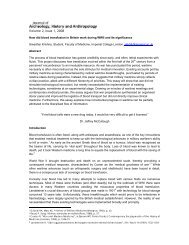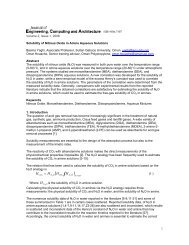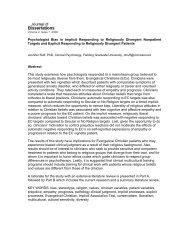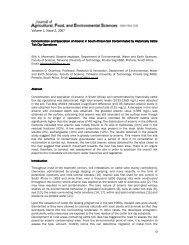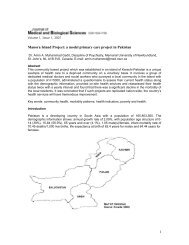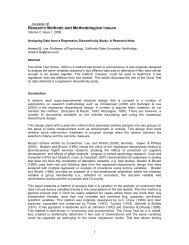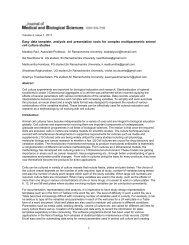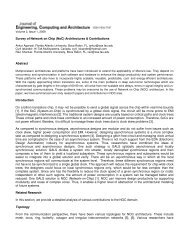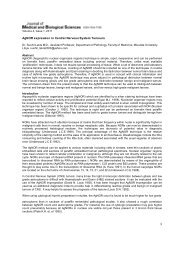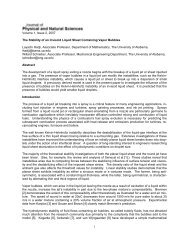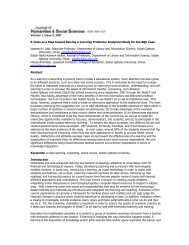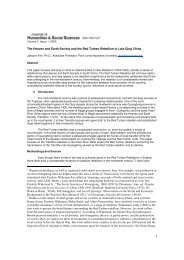A Simulated Annealing Based Approach for ATM Network Optimization
A Simulated Annealing Based Approach for ATM Network Optimization
A Simulated Annealing Based Approach for ATM Network Optimization
Create successful ePaper yourself
Turn your PDF publications into a flip-book with our unique Google optimized e-Paper software.
Volume 1, Issue 2, 2007<br />
A <strong>Simulated</strong> <strong>Annealing</strong> <strong>Based</strong> <strong>Approach</strong> <strong>for</strong> <strong>ATM</strong> <strong>Network</strong> <strong>Optimization</strong><br />
Susmi Routray, In<strong>for</strong>mation Technology, Institute of Management Technology, Ghaziabad,<br />
India, sroutray@imt.edu<br />
A. M. Sherry, In<strong>for</strong>mation Technology, Institute of Management Technology, Ghaziabad, India,<br />
sherry@imt.ac.in<br />
B. V. R. Reddy, School of In<strong>for</strong>mation Technology, GGSIP University, Kashmere Gate, Delhi,<br />
India, bvrreddy64@rediffmail.com<br />
Abstract<br />
The increasing importance of telecommunications <strong>for</strong> applications such as the internet and video on demand<br />
leads to a requirement <strong>for</strong> a high bandwidth network such as Asynchronous Transfer Mode (<strong>ATM</strong>). The<br />
design of an optimal <strong>ATM</strong> network is a complex comprehensive task. Some of the problem domains are the<br />
topology, connectivity and routing decisions. Given the complexity of <strong>ATM</strong> design problem, computer based<br />
network design tools can be very effective in solving such type of problem. The important aspect of design<br />
tool is the usage of meta-heuristics as the optimization algorithm. Large scale optimization problems<br />
comprise of many local maxima and minima, moving out of local minima are very important to get global<br />
optima. <strong>ATM</strong> network design being a large scale optimization problem simple heuristics alone are not<br />
sufficient enough to solve the problem. This paper explores an <strong>ATM</strong> network design tool based on <strong>Simulated</strong><br />
<strong>Annealing</strong> (SA). A new solution has been proposed based on SA that minimizes the cost of fiber ducts and<br />
installs a minimum net present cost PON (Passive Optical <strong>Network</strong>) <strong>ATM</strong> that satisfies the customer demand<br />
criterion. A comprehensive <strong>ATM</strong> design tool has been proposed in which the backbone network is connected<br />
using ring topology and the end-user connectivity is provided using star topology.<br />
Keywords: Asynchronous Transfer Mode, Passive Optical <strong>Network</strong>, <strong>Simulated</strong> <strong>Annealing</strong>, Meta-heuristics.<br />
Introduction<br />
<strong>ATM</strong> is a packet switched, connection oriented transfer mode based on asynchronous time division<br />
multiplexing. <strong>ATM</strong> is considered to reduce the complexity of the network and improve the flexibility of traffic<br />
per<strong>for</strong>mance [Raychaudhuri and Wilson, 1994]. In <strong>ATM</strong>, in<strong>for</strong>mation is sent out in fixed-size cells. Each cell<br />
in <strong>ATM</strong> consists of 53 bytes. Out of these 53 bytes, 5 bytes are reserved <strong>for</strong> the header field and 48 bytes<br />
are reserved <strong>for</strong> data field. <strong>ATM</strong> is Asynchronous as the recurrence of cells sent by an individual user may<br />
not necessarily be periodic. <strong>ATM</strong> integrates the multiplexing and switching functions and allows<br />
communication between devices that operate at different speeds [P. Wong and D. Britland, 1993]. The<br />
objective of <strong>ATM</strong> network planning is to design the network structure to carry the estimated traffic and also<br />
to minimize the cost of network [Gerla, 1989, Gerla, Kleinrock, 1977, Routray et. al., 2006]. Given the<br />
complexity of <strong>ATM</strong> network design problem, network design tools can be very effective in solving such<br />
problem. A large number of network optimization problems do not have any standard algorithm that can<br />
guarantee an optimal solution in real time. Mainly in large scale optimization problems which consist of<br />
many local optima but one global optima the general heuristics fail to give a satisfactory solution, as the<br />
general heuristics are not capable to find the global optima but only the local optima. So the most important<br />
aspect of having design tools is the usage of the meta-heuristics based optimization algorithms. These<br />
meta-heuristics based optimization techniques give better results in shorter time period than the manual<br />
based designs. As <strong>ATM</strong> network design problem [Liu, 2003, Carello, 2002] is a large scale network design<br />
problem <strong>Simulated</strong> <strong>Annealing</strong> has been chosen as the optimization algorithm. One of the important<br />
advantages of using SA - it does not prematurely converge to the local optima as is the case with genetic<br />
algorithm. So SA has been chosen <strong>for</strong> the study. Meta-heuristics like SA [Rios et. al., 2005] and GA has been<br />
used to solve the <strong>ATM</strong> network related problems [Routray et. al., 2005, Davis et. al. 1993, Davis et. al.,<br />
1987]. Abuali et. al. (1994) present a GA based algorithm <strong>for</strong> the capacitated concentrator location problem<br />
and develop a permutation-based representation. The resulting algorithm out-per<strong>for</strong>med a greedy heuristic<br />
on larger problems. Boorstyn et. al. [Boorstyn and Frank, 1977] compared the per<strong>for</strong>mance of the GA to<br />
results obtained from Lagrangian relaxation (LR). For uncapacitated problems [Balakrishnan et. al., 1989],
LR finds better solutions than the GA. <strong>ATM</strong> network design deals with determination of location <strong>for</strong> the<br />
switches and linking the switches [Hasslinger et. al., 2005]. One of the limiting factors in the design of the<br />
<strong>ATM</strong> network as can be deduced from the above literatures is the requirement of expensive exchange based<br />
equipments. [Thomson, 2000] Compared the meta-heuristics GA and SA to solve the design problem of <strong>ATM</strong><br />
but their approach to <strong>ATM</strong> design suffers from the abovementioned limitation. In this paper we have<br />
proposed Passive Optical <strong>Network</strong> as a solution to the problem. It provides a way to gradually introduce<br />
fiber optic technology into access networks while still deploying parts of the traditional copper line or coaxial<br />
cable systems. These networks allow many different configuration options and as such will place new<br />
demands on network planners. Most of the literatures available with respect to PON <strong>ATM</strong>’s pertain to the<br />
Steiner tree topology implementation. In this paper we have addressed and solved using <strong>Simulated</strong><br />
<strong>Annealing</strong> the comprehensive <strong>ATM</strong> network design problem which deals with the backbone network design<br />
using the ring topology. Ring architecture is considered cost effective in that they offer high network<br />
survivability in the face of node failure and greater bandwidth sharing [Wu, et. al., 1998]. And also the<br />
problem of end-user connectivity with the backbone network has been addressed.<br />
<strong>Simulated</strong> <strong>Annealing</strong><br />
The method was proposed by Kirkpatrick et al.(1993) and has since been used extensively to solve largescale<br />
problems of combinatorial optimization. SA is based on the annealing of metals. If a metal is cooled<br />
slowly, it <strong>for</strong>ms into a smooth piece because its thermal mobility is lost and molecules have entered a crystal<br />
structure. This crystal is the state of minimum energy can also be termed as the optimal solution <strong>for</strong> the<br />
system. On the other hand at high temperatures, the molecules of a liquid move freely with respect to one<br />
another and if a metal is cooled too fast, the metal will <strong>for</strong>m a rough piece. So the effectiveness of the<br />
simulated annealing algorithm lies in slow cooling of the temperature [Sheshadri]. One of the features of SA<br />
is its ability to come out of local minima as worst moves are allowed in the algorithm based on some<br />
probabilistic condition. In large scale optimization problem, which comprises of many local maxima and<br />
minima, moving out of local minima is very important to get global optima. The major steps involved in SA<br />
are- Initialization: defines how to get the initial feasible solution. The next step is the Iteration: defines the<br />
neighborhood, temperature schedule, how many iterations per temperature, and criteria <strong>for</strong> reducing the<br />
temperature. Last step Termination: defines a terminating condition.<br />
Problem Description<br />
While planning <strong>ATM</strong> network design there are two sets of customers to be considered, the user who would<br />
be using the services through the network and the company that will be building the <strong>ATM</strong> network and<br />
maintaining it. There<strong>for</strong>e while planning the <strong>ATM</strong> networks there are two principal objectives to be<br />
considered. One, the network should meet the end-users needs in terms of quality of service and cost. Two,<br />
<strong>for</strong> the network operator it should be as cost effective as possible to install and maintain the network. The<br />
second objective has traditionally been examined as reducing the first installed cost of the network.<br />
Minimizing the total cost is mainly a matter of finding shortest paths between the <strong>ATM</strong> nodes, as in installing<br />
a new network most of the money is spent on digging the cable ducts.
Figure 1: Schematic <strong>for</strong> an <strong>ATM</strong> planning<br />
PON <strong>ATM</strong>s can be implemented in several topologies. One such configuration is a ring structure where the<br />
OLT (Optical Line Termination) in the central office can be seen as the root and the ONU (Optical <strong>Network</strong><br />
Units) as the nodes in the ring. Customer access points are connected to the ONU in a star topology. These<br />
devices take an optical fiber as input and split the signal carried on this fiber over a number of fibers on the<br />
output. Signal attenuation constraints require that the signal is only split at a maximum of two points<br />
between the exchange and customer. The first splitting point in the network is called the primary node. The<br />
second point at which the signal is split is called the secondary node. Typically 32 ONU’s can be connected<br />
to one OLT. The diagram [Figure 1] shows a ring of fiber connecting the primary nodes and the method of<br />
connecting the end-users to these primary nodes. In this paper we have considered the case where there is<br />
a single connection from the primary to secondary node and from the secondary node to customer. This is<br />
likely to be the most common installation strategy <strong>for</strong> the <strong>ATM</strong> network as back-up links are very expensive.<br />
When installing a new network in the access area, the majority of money has to be spent on digging the<br />
cable ducts. Thus, minimizing the total cost is mainly a matter of finding the shortest street paths which<br />
interconnect all ONUs with the OLT. A city map can be represented by a graph where the streets are the<br />
links, and the street junctions together with the ONUs and the OLT make up the nodes. In this paper we<br />
have taken the location of the exchange, the location of potential end-users, and a <strong>for</strong>ecast of these endusers’<br />
demand in terms of number of lines and year as given. Variables are the - primary and secondary<br />
node locations, cable sizes and routes, duct capacity and routes, assignment of end-users to secondary<br />
nodes, and the assignment of secondary nodes to primary nodes. The network must be implemented<br />
subject to the constraints of - attenuation, maximum distance between a node and lastly a customer and<br />
planning rules. The aim of the planner is to satisfy both the network’s end-users and the network operator,<br />
by producing a reliable cost-effective network.<br />
Objective<br />
The objective of the optimization is to install a minimum net present cost network that satisfies the<br />
customer demand criterion. This problem can be classified as a dynamic network optimization problem<br />
with a discontinuous cost function [Minoux, 1987]. Let the graph G=(V,E) be a set of V nodes and a set of E<br />
edges. A ring is a sequence of vertices with n number of nodes v 1 , v 2 ,… v n , such that {v i ,v i+1 }, <strong>for</strong> all<br />
1
the distance between the end-node and the secondary node will be less than or equal to k. Also to optimize<br />
the time at which cable is installed into the network to create a network that uses the above allocations,<br />
split levels and positioning. A heuristic method has been used to achieve this installation strategy. Heuristic<br />
used is:<br />
1. Set year, y=0<br />
2. For each customer with demand in y, connect it to the secondary nodes to which it is assigned by<br />
the shortest route through the duct network.<br />
3. For each secondary node connected in the previous step connect it to the primary node to which it<br />
is assigned.<br />
4. If y is the final year of the planning period then finish else increment y and go to 2.<br />
This heuristic has been included in the objective function of a genetic algorithm so that iteration is not<br />
required between the two stages. Costing of the installation is based on the net present worth of the plant<br />
in the year it is installed.<br />
<strong>Network</strong> <strong>Optimization</strong> Using SA<br />
Begin<br />
Generate an initial solution p i<br />
Compute the objective function to find the cost of f (p i )<br />
Set the effective temperature, t, to the initial value, t 0<br />
While t t n do<br />
Randomly select a neighbor,<br />
Compute the objective function i.e. Cost f (p j )<br />
Find the difference d=f (p j )-f (p i )<br />
If d
Figure 2: Optimum network with 50 nodes using SA<br />
Comparison Chart <strong>for</strong> Average Cost and<br />
Best Cost<br />
9000<br />
8000<br />
7000<br />
6000<br />
Average cost<br />
Best cost<br />
Cost<br />
5000<br />
4000<br />
3000<br />
2000<br />
1000<br />
0<br />
0<br />
10<br />
20<br />
30<br />
40<br />
50<br />
60<br />
70<br />
80<br />
90<br />
100<br />
110<br />
120<br />
130<br />
140<br />
150<br />
160<br />
Generations<br />
Figure 3: Comparison chart <strong>for</strong> Average Cost and Best cost with 50 nodes.<br />
Table 1: Results obtained in phase I<br />
<strong>ATM</strong> nodes<br />
Phase I<br />
SA time<br />
SA cost<br />
30 2min 2435<br />
50 5min 4677.43<br />
100 10min 30secs 8997.78<br />
The allocation of end-users to secondary and primary nodes can be treated as an ordering problem. The<br />
approach taken is to represent the problem using an ordered list of end-users. The first n end-users from<br />
the list are assigned to the first secondary node, the second n end-users to the second node, etc. Unlike<br />
many optimization techniques, SA works effectively with discontinuous cost functions. The cost of assigning<br />
a customer to a node is calculated by finding the shortest path from the customer through the network of<br />
ducts to the node. The constraint that has been considered <strong>for</strong> assigning the end-users to the secondary<br />
nodes is that no more than 8 end-users can be connected to a single secondary node. The best results are<br />
shown <strong>for</strong> end-user networks using SA (Figure 4). In the figures a network with 100 end-users has been<br />
considered. It can be observed from the resultant network, the majority of the nodes in the network
obtained by SA supply nearby clusters of end-users. But one of the limiting factors of SA is the time. The<br />
time taken by SA is considerably higher (Table 2). As slow cooling is very important to generate near<br />
optimal solutions in SA, we have taken a cooling factor of 0.9 based on the outcome of series of test run. It<br />
has been observed, if the cooling factor is taken as higher the results obtained are not satisfactory as fast<br />
cooling schedule is equivalent to the greedy algorithm [Sheshadri].<br />
Figure 4: End-users connected to secondary nodes and secondary nodes connected to primary nodes in<br />
star topology using SA.<br />
Table 2: Results obtained in phase II<br />
<strong>ATM</strong> nodes Phase – II<br />
SA time<br />
30 5min<br />
50 9min 10 secs<br />
100 20min 45secs<br />
Conclusion<br />
A <strong>Simulated</strong> <strong>Annealing</strong> based optimization system <strong>for</strong> <strong>ATM</strong> network has been designed, implemented and<br />
tested. From the simulation results it can be concluded that SA based optimization provides a good network<br />
design tool <strong>for</strong> the <strong>ATM</strong> design problem. Firstly SA has been used to connect the primary nodes in ring<br />
topology and secondly the end-users have been connected to the secondary nodes in star topology using SA<br />
and then the secondary nodes are connected to the nearest primary node. Though one of the limiting factor<br />
that can be inferred from the simulation results in the design of <strong>ATM</strong> network using SA is the time required.<br />
The time required to generate the results are quite high but considering the strategic and financial<br />
implications <strong>for</strong> communications providers, cost is very important factor in network planning. So it is very<br />
important that fiber networks are implemented in a cost-effective manner. Minimizing the total cost is<br />
mainly a matter of finding shortest paths between the <strong>ATM</strong> nodes, as in installing a new network most of<br />
the money is spent on digging the cable ducts. So it can be inferred that computer based technique using<br />
meta-heuristic like SA is a powerful tool <strong>for</strong> reducing the complexity of the planning task and allows more<br />
flexibility in the management of uncertain data. An optimization system such as the one described here will<br />
enable a planner to evaluate a large number of scenarios under different conditions.<br />
References<br />
Abuali F.N., Schoenefeld D.A., & Wainwright R.L. (1994), "Terminal assignment in a communications<br />
network using genetic algorithms”, Proc. 22nd Annual ACM Computer Science Conference (CSC’94),<br />
Phoenix, Arizona, USA, 74-81.<br />
Balakrishnan A., Magnanti T., and Wong T. (1989), “A Dual-Ascent Procedure <strong>for</strong> large scale uncapacitated<br />
<strong>Network</strong> Design”, INFORMS Operation Research, 37, pp. 716-740.
Boorstyn R.R. and Frank H., (1977), “Large-Scale <strong>Network</strong> Topological <strong>Optimization</strong>”, IEEE Transactions on<br />
Communications, Vol. COM-25, No. 1, 29-47.<br />
Carello G., Della Croce F., Giovanni L. De, Quagliotti M., Tadeo R. (2002), “Optimal Telecommunication<br />
<strong>Network</strong> Design: problems, methods and applications”, exp, volume 2, no. 3, 27-31.<br />
Davis L., Cox A., Qiu Y.(1993), “A Genetic Algorithm <strong>for</strong> Survivable <strong>Network</strong> Design”, Proc. Fifth<br />
International Conference on Genetic Algorithms, Morgan Kauffman, 1993, pp 408-415.<br />
Davis L., Coombs S. (1987), “Genetic Algorithm and Communication Link Speed Design: Theoretical<br />
Considerations”, Proc. Second International Conference on Genetic Algorithms, Lawrence Erlbaum, 1987, pp<br />
252-256.<br />
Gerla M., Monteiro J. A. S., Pazos R. (1989), “Topology Design and Bandwidth Allocation in <strong>ATM</strong> Nets”,<br />
IEEE. JSAC, Vol. 7, No. 8, pp. 1253-1262.<br />
Gerla M., Kleinrock L. (1977), “On the topological design of Distributed Computer <strong>Network</strong>s”, IEEE<br />
Transactions on Communications, Vol. 25, No. 1, pp.55-67.<br />
Hasslinger, G., Schnitter, S., Franzke, M. (2005), “The Efficiency of Traffic Engineering with regard to Link<br />
Failure Resilience”, Telecommunication Systems Journal 29, 2005, 109-130.<br />
Kirkpatrick S, Gelatt C. D., Vechhi M. P.(1993), “<strong>Optimization</strong> by <strong>Simulated</strong> <strong>Annealing</strong>” Science, 220, pp 671-<br />
680.<br />
Liu Xian (2003), “<strong>Network</strong> capacity allocation <strong>for</strong> traffic with time priorities”, Int. J. <strong>Network</strong> Mgmt 2003, vol.<br />
13 pp. 411-417.<br />
Miguel Rios, Vladimir Marianov, and Cristian Abaroa (2005), “Design of Heterogeneous Traffic <strong>Network</strong>s<br />
Using <strong>Simulated</strong> <strong>Annealing</strong> Algorithms”, ICOIN 2005, LNCS 3391, pp. 520-530.<br />
Minoux M. (1987), "<strong>Network</strong> Synthesis and Dynamic <strong>Network</strong> <strong>Optimization</strong>" Annals of Discrete mathematics,<br />
31:283–324.<br />
Raychaudhuri D. and Wilson D. (1994), "<strong>ATM</strong>-<strong>Based</strong> Transport Architecture <strong>for</strong> Multiservices Wireless<br />
Personal Communication <strong>Network</strong>s ", IEEE Journal On Selected Areas In Communications, vol 12, No 8, pp<br />
1401 – 1413.<br />
Routray S., Sherry A. M., Reddy B. V. R.(2005), “A Genetic Algorithm <strong>Approach</strong> <strong>for</strong> Dynamic Routing of <strong>ATM</strong><br />
<strong>Network</strong>s”, Paradigm Vol. IX, No. 1, January-June 2005, pp 86-92.<br />
Routray S., Sherry A. M., Reddy B. V. R. (2006), “Bandwidth <strong>Optimization</strong> through Dynamic Routing in <strong>ATM</strong><br />
<strong>Network</strong>s: Genetic Algorithm &Tabu Search <strong>Approach</strong>” IJCS International Journal of Computer Science, Vol.<br />
1, No. 3, pp 188-194.<br />
Seshadri A., “<strong>Simulated</strong> <strong>Annealing</strong> <strong>for</strong> Travelling salesman problem”.<br />
Thompson D. R., Bilbro G. L. (2000), “Comparison of a genetic algorithm with a simulated annealing<br />
algorithm <strong>for</strong> the design of an <strong>ATM</strong> network”, Communications Letters, IEEE Volume 4, Issue 8, Page(s):267<br />
– 269.<br />
Wong P. and Britland D. (1993), “Mobile Data Communication ", Artech House, 1993.<br />
Wu T., Kolar D. J., and Cardwell R. H.(1998), “ Survivable <strong>Network</strong> Architectures <strong>for</strong> Broadband Fiber Optic<br />
<strong>Network</strong>s: Models and Per<strong>for</strong>mance Comparisons”, IEEE Journal of Lightwave Technology, vol. 6, no. 11,<br />
pp. 1698-1709.<br />
en.wikipedia.org/wiki/GPON.



